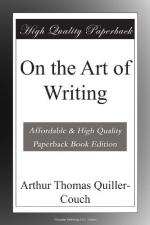Why, it runs straight off into English verse—
When grass is green
and leaves appear
With flowers in bud
the meads among,
And nightingale aloft
and clear
Lifts up his voice and
pricks his song,
Joy, joy have I in song
and flower,
Joy in myself, and in
my lady more.
And that may be doggerel; yet what is it but
It was a lover and his
lass,
With a hey and a ho
and a hey nonino,
That o’er the
green cornfield did pass
In the spring-time,
the only pretty ring-time—
or
When daffodils begin
to peer,
With heigh! the doxy
over the dale,
Why then comes in the
sweet o’ the year;
For the red blood reigns
in the winter’s pale.
Nay, flatter the Anglo-Saxon tradition by picking its very best—and I suppose it hard to find better than the much-admired opening of Piers Plowman, in which that tradition shot up like the flame of a dying candle:
Bote in a Mayes Morwnynge—on
Malverne hulles
Me bi-fel a ferly—a
Feyrie me thouhte;
I was weori of wandringe—and
wente me to reste
Under a brod banke—bi
a Bourne syde,
And as I lay and leonede—and
lokede on the watres,
I slumberde in a slepynge—hit
sownede so murie.
This is good, solid stuff, no doubt: but tame, inert, if not actually lifeless. As M. Jusserand says of Anglo-Saxon poetry in general, it is like the river Saone—one doubts which way it flows. How tame in comparison with this, for example!—
In somer, when the shawes
be sheyne,
And leves be large and
long,
Hit is full mery in
feyre foreste
To here the foulys song:
To se the dere draw
to the dale
And leve the hilles
hee,
And shadow hem in the
leves grene
Under the grene-wode
tre.
Hit befel on Whitsontide,
Erly in a May mornyng,
The Son up feyre can
shyne,
And the briddis mery
can syng.
‘This is a mery
mornyng,’ said litell John,
’Be Hym that dyed
on tre;
A more mery man than
I am one
Lyves not in Cristiante.
‘Pluk up thi hert,
my dere mayster,’
Litull John can sey,
’And thynk hit
is a full fayre tyme
In a mornyng of May.’
There is no doubting which way that flows! And this vivacity, this new beat of the heart of poetry, is common to Chaucer and the humblest ballad-maker; it pulses through any book of lyrics printed yesterday, and it came straight to us out of Provence, the Roman Province. It was the Provencal Troubadour who, like the Prince in the fairy tale, broke through the hedge of briers and kissed Beauty awake again.




